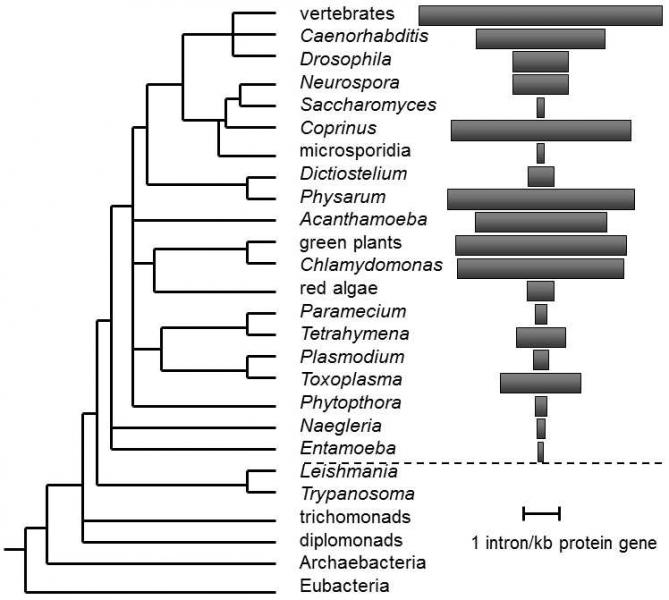XI.7.1 The absence of introns in the genes of prokaryotes does not tell us anything about the evolutionary age of these structures
One of the very obvious differences between eukaryotes and prokaryotes is the presence of introns.A large part of the genes of higher eukaryotes (animals, plants, fungi, many groups of protozoa) contain introns, while practically all the genes of prokaryotes have no introns (Fig. XI.6).Primarily, the

Fig. XI.6 Contents of introns in the genes of various taxons. The width of the blocks in the right-hand part of the figure corresponds to the number of spliceosome introns per kb of coding sequence. Spliceosome introns were found in diplomonad, kinetoplasmid and trichomona relatively recently and in only a very few genes. The phylogenetic tree, based primarily on the rRNA sequence, has undergone substantial changes since the time of its publication. Modified according to Logsdon (1998)
introns occurring in the genes for tRNA abd rRNA in eukaryotes and prokaryotes are exceptions; however, these are self-splicing introns of groups I and II, i.e. introns that do not use cellular organelle spliceosome for splicing from the RNA (Belfort & Weiner 1997).As a consequence of our highly anthropogenic view of nature, most biologists until recently believed that the original type of cell was a prokaryotic cell, similar to the cells of present-day bacteria, and that the structure of prokaryotic genes is thus also more similar to the structure of the genes of the first organisms.The eukaryotic type of cell was generally considered to be a more modern, derived type that developed from prokaryotic cells only in later stages of evolution.
In a certain sense, this conception is justified, as the modern eukaryotic cell, containing symbiotically formed organelles, plastids and mitochondria, was formed by symbiogenesis possibly only about 1.5 million years ago.However, there are a number of eukaryotic organisms that do not have either plastids or mitochondria and, although modern data does not much support this, it cannot be excluded that at least some of them (or other, presently unknown organisms) never had any.Contemporary knowledge of the phylogenesis of bacteria and archaebacteria simultaneously indicate that the prokaryotic type of cells of modern bacteria and archaebacteria could be to a great degree derived and that the original organisms could have been quite similar to eukaryotic cells.
Whatever the evolutionary relationship of prokaryotes and eukaryotes, this aspect is not directly connected with the question of the presence or absence of introns in primitive genes.It would be very naive to imagine that evolutionarily older types of cells would have to have all their properties (for example, the structure of genes) more similar to the original state.When we speak about the evolutionary age or modernity of certain structures, we are referring to the degree of anagenesis that they have attained.The attained level of anagenesis of the individual structures is not related to cladogenesis, i.e. to the order in which the individual sister taxa branched off from their common ancestor.This depends primarily on the intensity and direction of the selection pressures to which the particular species of organism was exposed during evolution.
Thus, at least two alternative scenarios of the origin of present-day introns can be just as easily imagined.The ancestors of modern organisms could have had introns in their genes and, following splitting off of the branch leading to prokaryotes and eukaryotes, the prokaryote could have lost its introns as a consequence of selection pressure for rapid reproduction.In order for a cell to reproduce as rapidly as possible, it is necessary that it replicate its DNA.Thus, it is advantageous for it to remove as many unnecessary DNA areas as possible, including introns.Similarly, it is, of course, also possible that the common ancestor did not have introns in its genes and, only after splitting off of the evolutionary branches, did the ancestors of present-day eukaryotes acquire them as a consequence of certain selection pressures (see below).It is simultaneously of no consequence for the validity of the two scenarios whether the common ancestor was similar to modern eukaryotes or prokaryotes.
